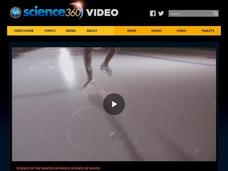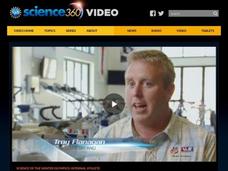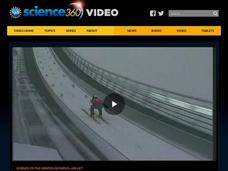National Geographic
Bobcat Kitten Hunting Lesson | America's National Parks
A mother bobcat teaches her kittens how to hunt and catch their lunch. ➡ Subscribe: http://bit.ly/NatGeoSubscribe ➡ Get More America’s National Parks: http://bit.ly/NGAmericasNationalParks About America’s National Parks: America’s...
National Science Foundation
Olympics Motion—Science of the Winter Olympics
What makes the elite athletes elite? Young scholars watch a thorough video lesson that describes the science of muscle movement. The narrator explores the physical requirements of different sports.
National Science Foundation
Science of Skates—Science of the Winter Olympics
Speed skaters, hockey players, and ice skaters each have skates created specifically for their sports—an interesting fact for your Olympic Games fans! An engaging lesson explores the engineering design of different types of ice...
National Science Foundation
Science of Skis—Science of the Winter Olympics
The materials used to produce skis have come a long way over the years. A short video explains how the materials in skis serve a specific purpose on the course. The lesson explores materials such as fiberglass and polymers.
National Science Foundation
Slapshot Physics—Science of the Winter Olympics
Take a shot at explaining the physics of hockey! Olympic hockey players explain the science of their craft in a video lesson. The lesson includes a discussion of force and velocity as well as potential and kinetic energy.
National Science Foundation
Downhill Science—Science of the Winter Olympics
Newton would have made a first-rate skier! A video lesson analyzes Newton's second law from a skiing perspective. The narrator explains how the force, mass, and acceleration can work together to create a winning run.
National Science Foundation
Internal Athlete—Science of the Winter Olympics
Cross-country skiers are some of the most disciplined athletes in the world. Young scholars learn about the biology of endurance in an interesting video lesson that highlights athletes of current and past Olympics.
National Science Foundation
Mathletes—Science of the Winter Olympics
Investigate the mathematics of the Olympics. A science video how mathematics is important from the basic level of calculating scores to the more complex math of describing the velocity of motion. Scholars learn to view Olympic...
National Science Foundation
Suit Up—Science of the Winter Olympics
You are what you wear! Learn the complex design strategies that result in the competition clothing seen in the Olympics. Scientists consider the requirement of each sport, which typically results in resisting air drag.
National Science Foundation
Aerial Physics—Science of the Winter Olympics
Take a leap into the science of motion! An intriguing lesson explains how Newton's third law of motion allows skiers to turn in mid-air. The narrator gives learners skills to practice on their own.
National Science Foundation
Engineering the Half Pipe—Science of the Winter Olympic Games
There are no tricks here! Young scholars learn about the concept of centripetal acceleration by studying the design of the snowboarding half pipe. A video lesson describes how the half pipe design affects the motion of the boarders.
National Science Foundation
Banking on Speed—Science of the Winter Olympics
Get on the right track! Young scholars learn about the importance of momentum and friction during a bobsled ride. A video lesson speaks to a bobsled designer to explain how he considers the physics during the design process.
National Science Foundation
Safety Gear—Science of the Winter Olympics
Safety first! A science video explores the design of safety helmets. It considers both elastic and inelastic collisions.
National Science Foundation
Air Lift—Science of the Winter Olympics
Up, up, and away! Young scholars learn how to apply physics to a successful ski jump. An interesting video lesson compares and contrasts drag and lift in the context of a ski jump.
National Science Foundation
Science of the Winter Olympic Games: Engineering Faster and Safer Bobsleds
While your physical science class is studying mechanics, this would be a fabulous enrichment video for covering aerodynamics or friction. Mechanical engineers dedicate their time to developing Olympic-quality bobsleds to be as fast, but...
National Science Foundation
Snowboarding—Science of the Winter Olympics
The greatest challenge of snowboarding is maintaining balance. An engaging video using a simple demonstration of actual snowboarders to illustrate physics in action.
MinutePhysics
The Most Burly Hurls
It's time for a throw-down of Olympic proportions! Learners explore the energy track stars use to toss four field-event items: the javelin, shot put, hammer, and discus. The narrator then relates the energy used in throwing to...
TED-Ed
An Athlete Uses Physics to Shatter World Records
Have you heard of the Fosbury Flop? It was invented by a college high jumper in and has become the standard technique for high jumpers world wide. Learn the physics of this move and why it is more effective for clearing the bar than the...
MinutePhysics
Usain Bolt vs. Gravity
How fast is fast? Can a mortal man really beat nature? Pupils explore the concepts of gravity, distance, and falling objects featuring gold medalist Usain Bolt. The narrator details the outcome of Bolt in a foot race against a falling...
TED-Ed
Why do Animals Form Swarms?
Swarms contain no leader, yet often act with an intelligence higher than any individual member. Birds, insects, and fish all commonly swarm for a variety of reasons. Scholars learn about swarming behavior in a short video before...
Curated OER
Gold, Silver, & Bronze
The teacher focuses on the chemistry of the metals in Olympic medals. This video is a different approach to teaching about metals, covering a variety of concepts: elements, alloys, properties of metals, atomic structure, and the periodic...
American Chemical Society
How is Artificial Snow Made?
It's time to take to the slopes to enjoy a little scientific exploration. Scholars learn the chemistry of artificial snow by watching an informative video. The ACS Reactions lesson describes the importance of creating the correct...
NBC
Nbc Learn: Science of the Olympic Winter Games
16 amazing videos exploring the science and mathematics, behind the Winter Olympic games. Be intrigued and the thought, precision, and passion behind the world's greatest sporting events. Sign up for lesson plans and activities.






















